 Mormon ReligionWritten by: John Gordon Melton
Mormon ReligionWritten by: John Gordon Melton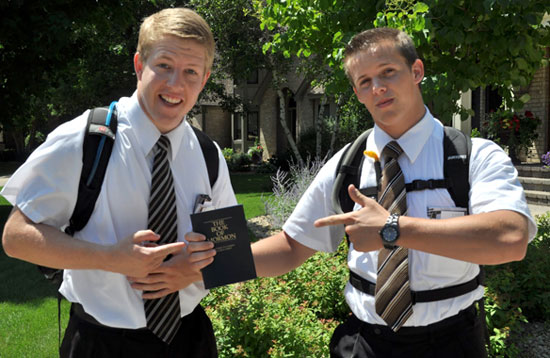 Mormon missionaries
Mormon missionariesMormon, member of any of several denominations that trace their origins to a religion founded by Joseph Smith, Jr. (1805–1844), in the United States in 1830. The term Mormon, often used to refer to members of these churches, comes from the Book of Mormon, which was published by Smith in 1830. Now an international movement, Mormonism is characterized by a unique understanding of the Godhead, emphasis on family life, belief in continuing revelation, desire for order, respect for authority, and missionary work. Mormons also obey strict prohibitions on alcohol, tobacco, coffee, and tea and promote education and a vigorous work ethic.
The Church of Jesus Christ of Latter-day Saints, the principal formal body embracing Mormonism, is headquartered in Salt Lake City, Utah, and had more than 11 million members by the early 21st century. About 50 percent of the church’s members live in the United States and the rest in Latin America, Canada, Europe, Africa, the Philippines, and parts of Oceania. The next largest Mormon denomination, the Community of Christ (until 2001 the Reorganized Church of Jesus Christ of Latter Day Saints), is headquartered in Independence, Missouri, and had a membership of approximately 250,000 in the early 21st century.
History Joseph Smith, Jr. (1805–1844), founder of the Mormon faith
Joseph Smith, Jr. (1805–1844), founder of the Mormon faithIn western New York state in 1823,
Smith had a vision in which an angel named
Moroni told him about engraved golden plates buried in a nearby hill. According to
Smith, he received subsequent instruction from
Moroni and, four years later, excavated these plates and translated them into English. The resultant
Book of Mormon—so called after an ancient American prophet who, according to
Smith, had compiled the text recorded on the plates—recounts the history of a family of Israelites that migrated to America centuries before
Jesus Christ and were taught by prophets similar to those in
the Old Testament. The religion
Smith founded originated amid
the great fervour of competing Christian revivalist movements in early 19th-century America but departed from them in its proclamation of a new dispensation. Through
Smith,
God had restored the “
true church”—i.e.,
the primitive Christian church—and had reasserted the true faith from which the various Christian churches had strayed.
 The statue of Moroni, the first of its kind, welcomes visitors into the city.
The statue of Moroni, the first of its kind, welcomes visitors into the city.The new church was
millennialist, believing in
the imminent Second Coming of Christ and
his establishment of a 1,000-year reign of peace. This belief inspired Smith’s desire to establish
Zion,
the kingdom of God, which was to be built somewhere in
the western United States. He received revelations, not only of theological truth but also day-to-day practical guidance.
The Mormons devised new secular institutions, including collective ownership (later changed to a system of tithing) and polygamy, which was practiced by Smith himself and by most leading Mormons in the church’s early years.
Soon after the church’s founding,
Smith and the bulk of the members moved to
Kirtland,
Ohio, where a prominent preacher,
Sidney Rigdon, and his following had embraced
Mormonism. In
Jackson county,
Missouri, where it was revealed that
Zion was to be established,
Smith instituted a communalistic
United Order of Enoch. But strife with non-Mormons in the area led to killings and the burning of Mormon property. Tensions between Mormons and local slave-owning Missourians, who viewed them as religious fanatics and possible abolitionists, escalated to armed skirmishes that forced 15,000 Mormons to leave Missouri for Illinois in 1839, where Smith built a new city,
Nauvoo. There the Mormons’ commercial success and growing political power once again provoked renewed hostility from their non-Mormon neighbours. Smith’s suppression of some dissidents among the Nauvoo Mormons in 1844 intensified non-Mormon resentment and furnished grounds for his arrest.
Smith and his brother Hyrum were murdered by a mob while both were in jail in Carthage, near Nauvoo, on June 27, 1844.
 The Book Of Enoch
The Book Of Enoch After Smith’s unexpected death, the government of the church was left in the hands of the Council of the Twelve Apostles, whose senior member was Brigham Young. Ignoring several claimants to the church leadership, the majority of Mormons supported Young, who became the church’s second president. Increasing mob violence, however, made the Mormons’ continued presence in Nauvoo untenable, and Young thus led a mass 1,100-mile (1,800-km) migration to Utah in 1846–47. There the Mormons hoped to establish a commonwealth where they could practice their religion without persecution. Envisioning a new state that he called Deseret, Young helped to establish more than 300 communities in Utah and neighbouring territories. To build the population, he sent missionaries across North America and into Europe. Converts were urged to migrate to the new land, and it is estimated that about 80,000 Mormon pioneers traveling by wagon, by handcart, or on foot had reached
Salt Lake City by 1869, when the arrival of the railroads made the journey much easier.
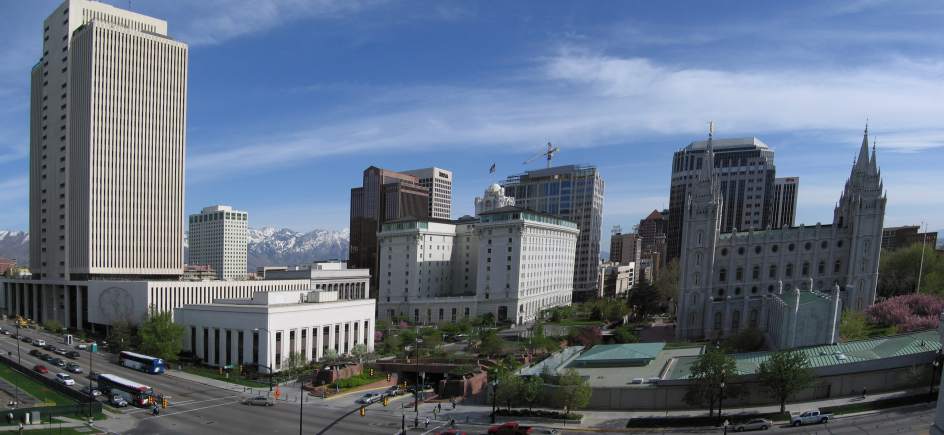 Salt Lake City
Salt Lake CityDespite the obstacles presented by the desert area of the Great Basin, the pioneers made steady progress in farming, partly through their innovative methods of irrigation. Their petition for statehood in 1849 was denied by the U.S. government, which instead organized the area as a territory, with Young as its first governor. Future efforts to gain statehood were blocked by the announcement in 1852 of the church’s belief in polygamy, a practice that had begun quietly among the church leaders during the Nauvoo period. Conflicts between Young and federal officials over this practice and over Mormon attempts to establish a theocratic government continued during the 1850s. Tensions increased following
the 1857 Mountain Meadows massacre, in which a group of Mormons killed members of a wagon train passing through the region. In response to the conflicts with federal officials,
U.S. Pres. James Buchanan dispatched a military expedition to Utah to suppress the Mormon “
rebellion” and to impose a non-Mormon governor, Alfred Cummings, on the territory. Fearing that the purpose of the expedition was to persecute the Mormons, Young called on the Utah militia to prepare to defend the territory. A negotiated settlement was reached in 1858, and Cummings, the new governor, eventually became popular with the Mormons. Although the abortive military episode, later known as “Buchanan’s blunder,” aroused widespread public sympathy for the Mormons, it succeeded in ending direct Mormon control of Utah’s territorial government.
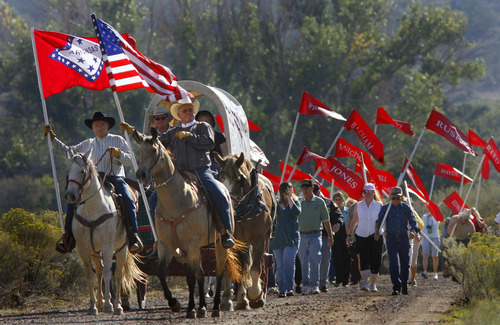 Descendants of the victims of the Mountain Meadow Massacre carry flags with their family names on them as they are led down the road by the Fancher Wagon Train, to the Mountain Meadow Massacre Memorial Grave Site, during the Mountain Meadows Massacre Memorial near Enterprise in September 2007. The site has been named a national landmark.
Descendants of the victims of the Mountain Meadow Massacre carry flags with their family names on them as they are led down the road by the Fancher Wagon Train, to the Mountain Meadow Massacre Memorial Grave Site, during the Mountain Meadows Massacre Memorial near Enterprise in September 2007. The site has been named a national landmark. U.S. Pres. James Buchanan
U.S. Pres. James BuchananAfter his death in 1877,
Young was succeeded by
John Taylor, the senior member of
the Council of the Twelve Apostles. During Taylor’s presidency, the U.S. government intensified its campaign against polygamy. In 1890 Taylor’s successor, Wilford Woodruff, announced the church’s abandonment of the practice in order to conform with U.S. law, and in 1896 the territory of
Utah was admitted into the union as the 45th state. However, Woodruff’s pronouncement, the“
Manifesto,” forbade polygamy only in the United States, and for a decade or so it continued in Mexico and other places outside the U.S. government’s jurisdiction.
 A polygamous Mormon family circa 1890.
A polygamous Mormon family circa 1890.In the history of Mormonism, more than 150 different independent groups have formed to follow new prophets, to defend polygamy, or to continue other practices that were discarded by the mainstream Mormon churches. An important minority of Mormons, for example, rejected Young’s leadership and remained in the Midwest. The largest of these groups, which gained the cooperation of Smith’s widow Emma and his son Joseph Smith III, formed the Reorganized Church of Jesus Christ of Latter Day Saints (now known as the Community of Christ) in 1852–60. The Reorganized Church eventually settled in Independence, Missouri, which Smith had designated as the location of Zion.
Many smaller splinter groups also arose after Smith’s death. One faction moved to Independence and purchased the so-called Temple Lot, the site chosen by Smith for the new temple. The possession of this valued property embittered relations with the Reorganized Church, whose headquarters were on land immediately to the south. Other factions that rejected Young’s leadership also appeared. Rigdon led one, and Apostle Lyman Wight took another to Texas. David Whitmer and Martin Harris, two early converts who, along with Joseph Smith, testified that they saw the golden plates and the angel Moroni, eventually set up a church in Kirtland. In 1847 James Jesse Strang established a polygamous community of about 3,000 people on Beaver Island in Lake Michigan whose members became known as Strangites.
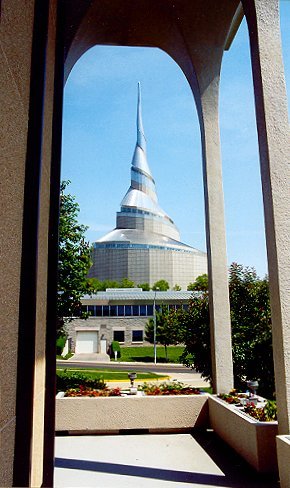 Temple Lot
Temple LotAmong the most significant of Latter-day Saints factions to emerge in the 20th century were groups that practice polygamy. The first such colony was established at Short Creek (now Colorado City), just south of the Utah border in northwestern Arizona, in 1902, shortly after the Church of Jesus Christ of Latter-day Saints imposed excommunication as the penalty for entering into or officiating over a plural marriage; additional colonies were later founded in Mexico and Salt Lake City. Church and federal authorities have attempted to stamp out the polygamy-practicing groups, which nevertheless claim a membership of more than 30,000.
ScripturesThe Community of Christ uses Smith’s unfinished translation of the Bible, which incorporates prophecies of his own coming and of the Book of Mormon. The church in Utah, however, prefers the King James Version. Of great importance to all Latter-day Saints is the Book of Mormon, which recounts the history of a group of Hebrews, led by the prophet Lehi, who migrated from Jerusalem to America about 600 bce. There they multiplied and split into two groups: the virtuous Nephites, who prospered for a time, and the hostile Lamanites, who eventually exterminated the Nephites.
Other revealed writings, including Smith’s translation of “Egyptian” texts that he declared to be the Book of Abraham, were incorporated into the Pearl of Great Price. The Doctrines and Covenants contains Smith’s ongoing revelations through 1844. The editions of the Utah church and of the Community of Christ add the revelations of their respective church presidents (who, like Smith, are regarded as prophets). The Community of Christ’s version of the Doctrines and Covenants omits several of Smith’s revelations that appear in the Utah edition.
DoctrinesMormon beliefs are in some ways similar to those of orthodox Christian churches but also diverge markedly. The doctrinal statement, the Articles of Faith, for example, affirms the belief in God, the eternal Father, in his Son, Jesus Christ, and in the Holy Spirit. But the three are considered to be distinct entities (a doctrine known as tritheism) rather than united in a single person in the Trinity. Although Mormons believe that Christ came to earth so that all might be saved and raised from the dead, they maintain that a person’s future is determined by his own actions as well as by the grace of God. They also stress faith, repentance, and acceptance of the ordinances of the church, including baptism by immersion and laying on of hands for the gifts of the Holy Ghost. Mormons administer the sacrament of the Lord’s Supper as a memorial of Christ’s death.
 Institutions and practices
Institutions and practicesThe Utah branch of Mormonism dissolves the distinctions between the priesthood and the laity. At age 12, all worthy males (a category which until 1978 generally did not include black men) become deacons in the Aaronic priesthood; they become teachers at age 14 and priests at age 16. About two years later they may enter the Melchizedek priesthood as elders, and thereafter they may enter the upper ranks of the church priesthood hierarchy. In addition to service in the priesthood, many Mormons accept the call to missionary work. Young men, generally between the ages of 18 and 21, undertake a 24-month proselytizing mission, as do young women of age 19 and older. Many older married couples serve as missionaries for 18 months. This missionary work helped to make Mormonism one of the fastest-growing religions in the world.

Baptism, a rite signifying repentance and obedience, is understood as essential for salvation. Baptism is administered to children at age eight and to adult converts and may be undertaken by proxy for those who died without knowledge of the truth. The Mormons’ interest in genealogy proceeds from their concern to save the deceased population of the earth; meticulous genealogical information is compiled in order to identify candidates for baptism by proxy. In 2010, after complaints from some Jewish groups, the Church of Jesus Christ of Latter-day Saints changed its procedure for collecting genealogical information, in order to prevent the names of Jews who had died during the Holocaust from being proposed for baptism by proxy.
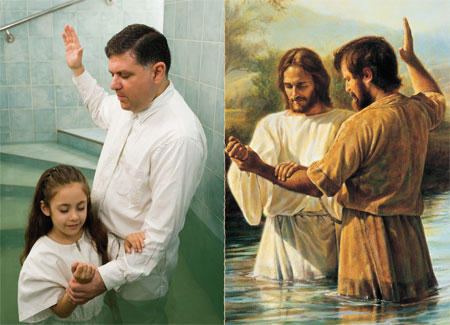 Mormon baptism
Mormon baptismBaptism for the dead, endowment (a rite of adult initiation in which blessings and knowledge are imparted to the initiate), and the sealing of husbands, wives, and children (which may also be undertaken by proxy for the dead) are essential ceremonies that take place in the temple. During the endowment, the person is ritually washed, anointed with oil, and dressed in temple garments. This is followed by a dramatic performance of the story of creation, the Fall, and the return of God.
 Baptism for the deadStructure of the Church of Jesus Christ of Latter-day Saints
Baptism for the deadStructure of the Church of Jesus Christ of Latter-day SaintsThe “
General Authorities” of the church are the First Presidency (the church president and two councillors), the Council of the Twelve Apostles, the First Quorum of Seventy, and the presiding bishop and two councillors, who manage the church’s property and welfare programs. All are “sustained in office” by the regular and now ritualized vote of confidence at the semiannual General Conference, which is open to all Mormons and to outside observers as well. Until the year 2000, conferences were held in the dome-shaped tabernacle east of the temple in Salt Lake City. Constructed between 1864 and 1867, the tabernacle was unable to accommodate conference attendance as well as the new LDS Conference Center, which has a capacity of 22,000.

At the local level, members of the church are divided into “
stakes” of 4,000 to 5,000 members under stake presidents and into wards, each of a few hundred members, under a bishop. The religious life of each member is focused on the ward, through which religious, economic, and social activities, tithing, and the operation of the church’s elaborate welfare plan are organized.
 Community of Christ
Community of ChristThe Community of Christ, which was known as the Reorganized Church of Jesus Christ of Latter Day Saints until 2001, holds less firmly to
the Book of Mormon than its sister church and rejects various teachings, especially baptism on behalf of the dead and tithing. It never practiced polygamy or sealing for the afterlife. It does not perform temple ceremonies at t
he Kirtland,
Ohio,
temple, which it owns, or at the temple in Independence.
The office of church president was for many years passed to lineal descendants of Joseph Smith III. With the end of the presidency of
Wallace B. Smith in 1996, however, no Smith descendant was available to take the reins of leadership. In that year, the church’s World Conference chose
W. Grant McMurray as its new president.

 W. Grant McMurray, president of the Church of Jesus Christ of Latter-day Saints World Conference
W. Grant McMurray, president of the Church of Jesus Christ of Latter-day Saints World Conference W. Grant McMurray is ordained in April 1996 as prophet-president of the Community
W. Grant McMurray is ordained in April 1996 as prophet-president of the CommunityJohn Gordon Melton
The Editors of Encyclopædia Britannica